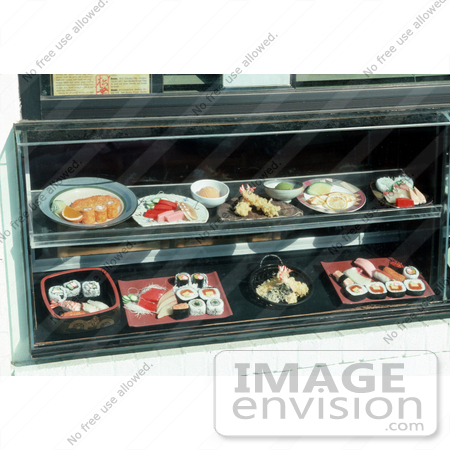|
This is a photograph of a refrigerated display case showing the offered meals at a Japanese restaurant; makizushi, sushi, shrimp dipped in batter and fried, many other varieties of sushi rolls with seaweed, meat and rice. Sushi is Japanese food, commonly made with vinegared rice, often raw but sometimes cooked fish meat, and other ingredients and vegetables. Traditionally the term "sushi" directly refers to the rice itself, however outside cultures use the term for the rolls, just raw fish alone (traditionally called sashimi), or meals that include raw fish. Rolls of sushi served with pressed and dried seaweed or alga sheets (nori) are makizushi. Sushi made with toppings in hand-formed clumps of rice are called nigiri-zushi. Items with the toppings stuffed into a pouch of fried tofu are called inarizushi. Items with scattered toppings over a bowl of sushi rice are called chirashi-zushi. Nigiri-zushi (nigiri-sushi) is a hand-formed sushi and is the most commonly seen form of restaurant sushi. It consists of mound of sushi rice which is pressed between the palms of the hands, wasabi and a slice of neta topping. This is sometimes bound with nori, and is usually served in pairs. Gunkan-maki is a special type of nigiri-zushi with an oval, hand-formed clump of sushi rice and a strip of "nori" wrapped around its perimeter to form a vessel that of which is then filled with toppings. Toppings are usuallysoft, loose or fine-chopped ingredients that require the confinement of nori: roe, natto, oysters, quail eggs, cucumber bits, macaroni salad or guacamole. Maki-zushi (Maki-sushi, rolled sushi) is a cylindrical piece, formed with the assistance of a bamboo mat (makisu) is usually wrapped in nori, but is sometimes wrapped in a thin omelette, sesame seeds, cucumber, or parsley and is commonly cut into 6 or 8 pieces, the number of an order. Below are some types of makizushi, but many other kinds not listed here. Futomaki (large/fat rolls) is a large cylindrical piece, with an outer coating of nori. Typically, futomaki is 1.5 inches in diameter, often made with 2-3 selected fillings that complement tastes and colors. Usually vegetarian, but it sometimes includes tiny fish eggs or similar toppings. Hosomaki (thin rolls) is a small cylindrical piece, with nori on the outside. Typically hosomaki has a diameter of about 0.75 inches and contain only one filling; tuna, cucumber, kampy, carrots (thinly sliced), and avocado. Kappamaki is a kind of Hosomaki filled with cucumber. Kappamaki is traditionally consumed to clear the palate between eating raw fish and other kinds of food, so flavors of the fish are distinct from the other foods. Tekkamaki is also a kind of Hosomaki raw tuna filling. Uramaki (inside-out rolls) is a medium-sized cylindrical piece, and filled with two or more fillings. The rice is on the outside and the nori is on the inside in this dish. The filling is in the center, coated by nori, then a layer of rice, and an outer coating of other ingredients like roe or toasted sesame seeds. It can be made with different fillings like tuna, crab meat, avocado, mayonnaise, cucumber, and carrots. This is not commonly seen in Japan and typically thought of as an invention to suit American tates. Increased popularity of sushi worldwide, has resulted in many kinds of uramaki and regional off-shoots being created, like the California roll, the B.C. roll made of grilled salmon skin, and the Philadelphia roll made with cream cheese. Temaki (hand rolls) are a large cone-shaped piece of nori on the outside with ingredients spilling out of the wide end. Usually a temaki 4 inches long, and is eaten as a finger because it is too difficult to eat with chopsticks. Inari-zushi (stuffed sushi) is a pouch of fried tofu, filled with just sushi rice. The pouch is normally fashioned as deep-fried tofu (abura age). Variations include pouches that are made of a thin omelet (fukusa-zushi or chakin-zushi) or dried gourd shavings (kanpyo). Oshizushi (pressed sushi) is a block-shaped piece formed by using a wooden mold (oshibako). The bottom of the oshibako is lined with the toppings, covered with sushi rice, the the lid of the mold is pressed down to make a compact, rectilinear block. The block is then removed from the molding and cut into pieces that are bite-sized and ready to eat. Chirashizushi (scattered sushi) is a bowl of sushi rice ingredients mixed in (barazushi). This dish is usually consumed in Japan because it is filling, fast, and simple to make. Narezushi (old style fermented and matured sushi) is an old form of sushi. Skinned and gutted fish are stuffed with salt, placed in a wooden barrel, doused with salt again, and then weighed down with a heavy tsukemonoishi (pickling stone). Then they are salted for 10 days or up to a month, placed in water for 15-60 minutes, then placed in another barrel, sandwiched, layered with cooled steamed rice and fish, partially sealed with otoshibuta and a pickling stone. Water seeps out over days, which must be removed. After 6 months, this funazushi can be eaten, and remains edible for another 6 months or more. [0003-0709-2615-5512] by 0003
|
